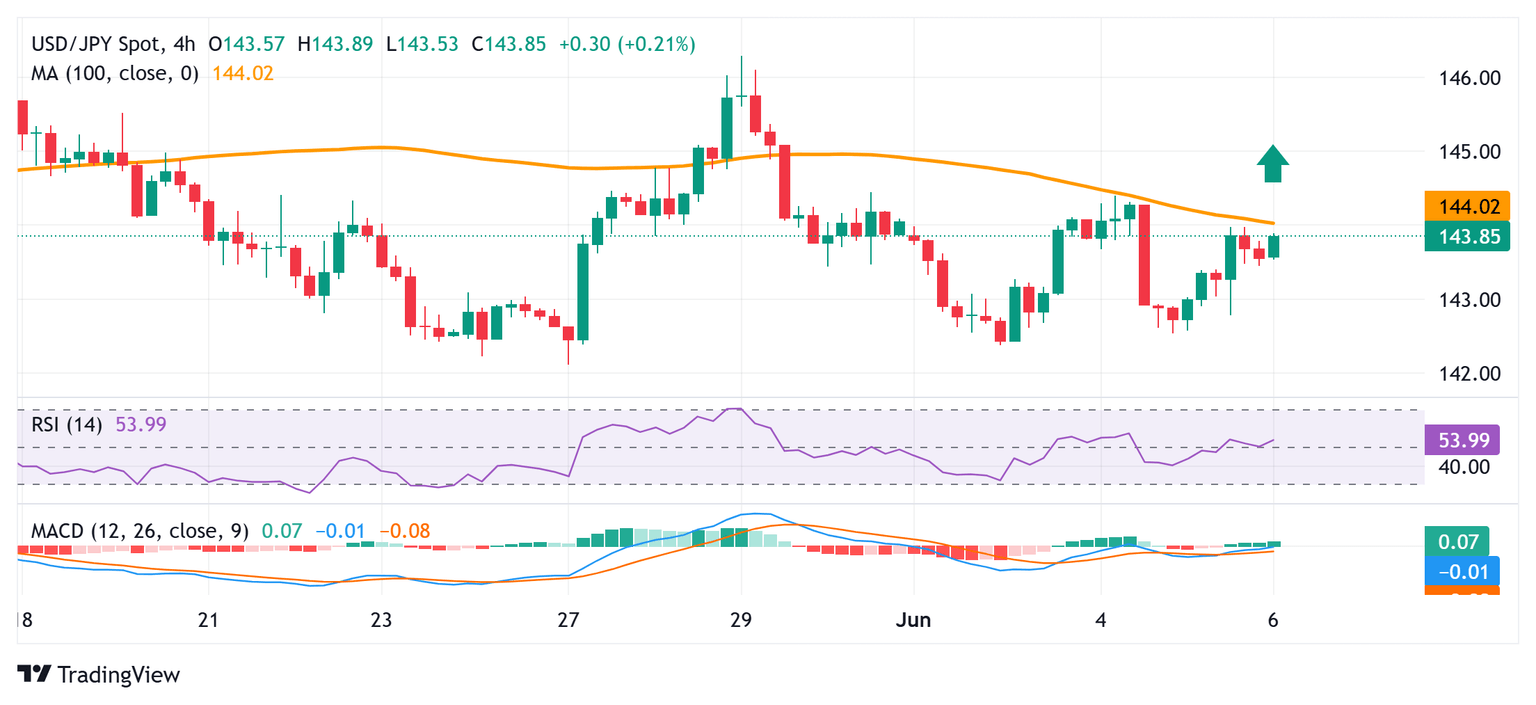Japanese Yen remains depressed against a broadly stronger USD; focus remains on US NFP report
- The Japanese Yen attracts sellers for the second straight day in reaction to disappointing domestic data.
- The optimism over the resumption of US-China trade talks further undermines demand for the safe-haven JPY.
- The divergent BoJ-Fed expectations should limit JPY losses and cap USD/JPY ahead of the US NFP report.

The Japanese Yen (JPY) maintains its offered tone against a broadly stronger US Dollar (USD), with the USD/JPY bulls awaiting a sustained move and acceptance above the 144.00 mark before placing fresh bets. In the meantime, the disappointing release of Japan's Household Spending data, along with the optimism over the resumption of US-China trade talks, undermines the safe-haven JPY. The USD, on the other hand, draws support from repositioning trades ahead of the crucial US Nonfarm Payrolls (NFP) report.
Any further JPY depreciation, however, seems elusive in the wake of the growing acceptance that the Bank of Japan (BoJ) will continue raising interest rates. This marks a big divergence in comparison to expectations that the Federal Reserve (Fed) will lower borrowing costs further in 2025, which should cap any meaningful USD upside amid US fiscal concerns and benefit the lower-yielding JPY. Apart from this, persistent geopolitical risks should limit JPY losses and hold back traders from placing fresh bullish bets around the USD/JPY pair.
Japanese Yen bulls remain on the sidelines, not ready to give up yet
- Government data released earlier this Friday showed that Japan's Household Spending unexpectedly fell by 0.1% from a year earlier in April as compared to the 2.1% increase recorded in the previous month. On a monthly basis, spending declined more than anticipated, by 1.8% during the reported month.
- The monthly wage data released on Thursday showed that real wages in Japan fell for a fourth consecutive month in April as rising prices continued to outpace pay hikes. This could further undermine private consumption, which contributes to over 50% of Japan’s GDP, and trigger an economic recession.
- The US Treasury Department, in its exchange-rate report to Congress, said on Thursday that the Bank of Japan should continue to proceed with monetary tightening. The report argued that doing so would support a healthier exchange rate and facilitate needed structural adjustments in trade flows.
- Japan reportedly is softening its stance on the 25% US auto tariff and instead is proposing a flexible framework to reduce the rate based on how much countries contribute to the US auto industry. Japan’s chief tariff negotiator, Ryosei Akazawa, is in Washington for the fifth round of talks with US officials.
- Meanwhile, US President Donald Trump and Chinese President Xi Jinping spoke on Thursday and agreed that officials from both sides will meet soon for more talks to resolve the ongoing trade war. Trump said that the call was focused almost entirely on trade and resulted in a very positive conclusion.
- The US Dollar remains close to its lowest level since April 22 touched the previous day amid increasing odds of an interest rate cut by the Federal Reserve in September. Traders, however, seem reluctant to place aggressive bets around the USD/JPY pair ahead of the US Nonfarm Payrolls (NFP) report later today.
USD/JPY needs to find acceptance above 144.00, 200-SMA on H4 to back the case for further gains

From a technical perspective, the USD/JPY pair has been oscillating in a familiar range since the beginning of this week, forming a rectangle on the daily chart. Against the backdrop of the downfall from the May monthly swing low, this might still be categorized as a bearish consolidation phase. Moreover, slightly negative oscillators on the daily chart suggest that the path of least resistance for spot prices is to the downside. Hence, any further move up is more likely to attract fresh sellers near the 144.00 round figure.
This is followed by the weekly high, around the 144.40 region. The latter coincides with the 100-period Simple Moving Average (SMA) on the 4-hour chart, which if cleared might shift the bias in favor of bullish traders and allow the USD/JPY pair to reclaim the 145.00 psychological mark.
On the flip side, weakness below the 143.50-143.45 area could be seen as a buying opportunity near the 143.00 round figure. Some follow-through selling, leading to a subsequent slide below the 142.75-142.70 region, could make the USD/JPY pair vulnerable to accelerate the downfall to the 142.10 region, or last week's swing low. A convincing break below the latter could make spot prices vulnerable to the recent downward trajectory and slide further to the next relevant support near the 141.60 area en route to sub-141.00 levels.
Economic Indicator
Nonfarm Payrolls
The Nonfarm Payrolls release presents the number of new jobs created in the US during the previous month in all non-agricultural businesses; it is released by the US Bureau of Labor Statistics (BLS). The monthly changes in payrolls can be extremely volatile. The number is also subject to strong reviews, which can also trigger volatility in the Forex board. Generally speaking, a high reading is seen as bullish for the US Dollar (USD), while a low reading is seen as bearish, although previous months' reviews and the Unemployment Rate are as relevant as the headline figure. The market's reaction, therefore, depends on how the market assesses all the data contained in the BLS report as a whole.
Read more.Next release: Fri Jun 06, 2025 12:30
Frequency: Monthly
Consensus: 130K
Previous: 177K
Source: US Bureau of Labor Statistics
America’s monthly jobs report is considered the most important economic indicator for forex traders. Released on the first Friday following the reported month, the change in the number of positions is closely correlated with the overall performance of the economy and is monitored by policymakers. Full employment is one of the Federal Reserve’s mandates and it considers developments in the labor market when setting its policies, thus impacting currencies. Despite several leading indicators shaping estimates, Nonfarm Payrolls tend to surprise markets and trigger substantial volatility. Actual figures beating the consensus tend to be USD bullish.
Author

Haresh Menghani
FXStreet
Haresh Menghani is a detail-oriented professional with 10+ years of extensive experience in analysing the global financial markets.

















